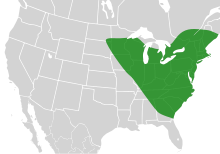Bombus affinis
| Bombus affinis | |
|---|---|
 |
|
| Photo of Bombus affinis queen, lacking the rust colouring of the worker and male | |
 |
|
| Scientific classification | |
| Kingdom: | Animalia |
| Phylum: | Arthropoda |
| Class: | Insecta |
| Order: | Hymenoptera |
| Family: | Apidae |
| Genus: | Bombus |
| Subgenus: | Bombus |
| Species: | B. affinis |
| Binomial name | |
|
Bombus affinis Cresson, 1863 |
|
 |
|
| The past range of Bombus affinis | |
Bombus affinis, commonly known as the rusty patched bumble bee, is a species of bumblebee endemic to North America. Its historical range in North America has been throughout the east and upper Midwest of the United States, north to Ontario, Canada, where it is considered a "species at risk", east to Quebec, south to Georgia, and west to the Dakotas. Its numbers have declined in 87% of its historical habitat range. On January 10, 2017, the United States Fish and Wildlife Service placed B. affinis on the list of endangered species, making the rusty patched bumblebee the first bee to be added to the list in the continental United States (seven species of yellow-faced bees native to the Hawaiian islands were added in 2016).
Members of B. affinis are relatively large in size, and like other species of bumblebees, are known to be eusocial organisms. Most nests constructed by B. affinis are built underground, and are commonly found in old rodent burrows. Nests created in captivity can house up to 2,100 members, but they are typically much smaller in the wild. This species consumes nectar and pollen from a variety of plants, including Abelia grandiflora, Asclepias syriaca, and Linaria spp. The colony odor is very similar to that of Bombus terricola, which makes it difficult for predators and parasites to differentiate between the two different species.
B. affinis is a member of the subfamily Apinae, and is most closely related phylogenetically to B. franklini, which is another species of bumble bee endemic to North America. The next-most closely related species, however, is B. terricola, which is very similar to B. affinis in terms of bodily pheromones. This similarity allows members of B. affinis to successfully dominate B. terricola workers after usurping their nests.B. affinis is in the company of nearly 250 other species of bumblebee worldwide in the genus Bombus, although only 50 are native to parts of the US and Canada. Unlike other members of the family Apidae, B. affinis workers and queens are characterized by different color patterns, which allow observers to tell them apart.
...
Wikipedia

